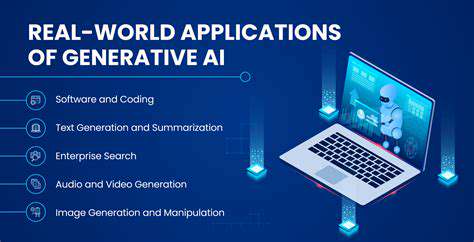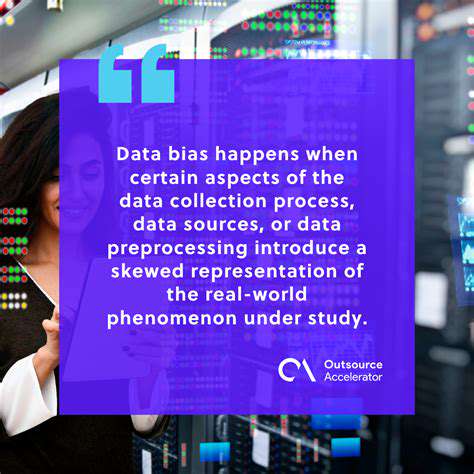Deploying and Maintaining Anomaly Detection Systems
Deployment Considerations
Deploying anomaly detection systems requires careful consideration of various factors, including the chosen algorithm, data volume, and infrastructure. The selection of the right algorithm is crucial, as different algorithms excel in different scenarios. For instance, a system designed for detecting network traffic anomalies might use different algorithms than one designed to detect anomalies in server performance. Furthermore, the sheer volume of data generated by modern networks can overwhelm a system if not properly managed. Efficient data preprocessing and storage techniques are vital for maintaining performance and scalability. Ultimately, the chosen infrastructure must be capable of handling the computational demands of the anomaly detection system, ensuring real-time alerts and accurate results.
Deployment strategies also need to be robust. A phased approach, beginning with a pilot program on a subset of the network, can help validate the system and identify potential issues before full deployment. Monitoring and logging are essential for troubleshooting and optimizing the system's performance. This involves setting up mechanisms for collecting logs related to detected anomalies, system performance, and user activity to provide valuable insights into the system's behavior.
Maintaining System Performance
Maintaining the performance of an anomaly detection system is an ongoing process, not a one-time event. Regular updates and adjustments are necessary to adapt to evolving network conditions and patterns. This involves continuous monitoring of false positive rates, ensuring that the system isn't generating excessive alerts for benign activities. Tuning the parameters of the detection algorithms is also critical to maintain sensitivity and specificity, ensuring that the system accurately identifies anomalies while minimizing false positives.
Regular performance evaluations are essential to ensure the system's continued effectiveness. This includes examining metrics such as detection accuracy, response time, and resource utilization. Data quality and relevance are paramount, and the system should be designed to accommodate evolving data sources and formats. System maintenance should also include periodic retraining of the anomaly detection models. This ensures the system remains current with the latest network behaviors and patterns, maximizing its effectiveness in identifying emerging anomalies.
Addressing False Positives
False positives are a common challenge in anomaly detection systems. They occur when the system flags a normal activity as an anomaly, leading to unnecessary alerts and potential disruptions. Effective strategies for mitigating false positives are critical for maintaining user trust and preventing operational issues. A crucial element is the refinement of the detection algorithms, enhancing their ability to discern between genuine anomalies and normal variations. Thorough analysis of the data associated with false positives is vital for understanding the underlying causes and developing appropriate countermeasures.
Scalability and Adaptability
Anomaly detection systems need to be scalable to accommodate growing network complexity and data volume. Scalability is achieved through the use of distributed computing architectures and cloud-based solutions. As the network evolves, the system should adapt to new types of attacks and threats. This requires continuous learning and updating of the anomaly detection models. Robust monitoring and feedback mechanisms are crucial to identifying and addressing any emerging patterns that the system might have difficulty recognizing. Regular updates and adjustments are essential for maintaining the system's effectiveness in identifying and responding to new threats and challenges.
Real-World Applications and Future Trends

Real-World Applications
The advancements in artificial intelligence (AI) have led to a plethora of real-world applications across various industries. From automating mundane tasks in manufacturing to providing personalized recommendations in e-commerce, AI is transforming how we live and work. These applications are not just theoretical; they are impacting businesses and individuals on a daily basis. AI is also revolutionizing healthcare, enabling faster diagnoses and more effective treatments. Imagine a world where medical diagnoses are made with greater accuracy and efficiency, saving lives and improving the overall quality of healthcare.
One particularly impactful area is customer service. AI-powered chatbots and virtual assistants are capable of handling a significant volume of inquiries, providing instant support, and resolving common issues. This not only improves customer satisfaction but also frees up human agents to focus on more complex problems. Furthermore, AI-driven insights are changing the way companies operate, allowing for better decision-making based on data analysis. This data-driven approach to business allows companies to optimize processes, reduce costs, and enhance profitability.
Future Implications
The future of AI promises even more profound transformations. We can anticipate significant advancements in areas like autonomous vehicles, personalized medicine, and smart cities. These technologies will undoubtedly reshape our daily lives, impacting transportation, healthcare, and urban planning in unprecedented ways. The integration of AI into various sectors will lead to a more efficient and interconnected world.
However, the rapid advancement of AI also raises important ethical considerations. Issues such as bias in algorithms, job displacement, and the potential misuse of AI technologies require careful consideration and proactive measures to ensure responsible development and deployment. Addressing these ethical concerns is crucial for harnessing the full potential of AI while mitigating its potential risks.
The potential for AI to revolutionize education is also significant. Imagine personalized learning experiences tailored to individual student needs, providing customized feedback and support to foster a deeper understanding of complex subjects. AI-powered tools can also assist educators in grading assignments and identifying areas where students need additional help. This could lead to a more effective and engaging learning environment for everyone.
Further advancements in robotics and automation will undoubtedly impact manufacturing and logistics. Imagine factories where robots perform complex tasks with precision and speed, leading to higher productivity and reduced costs. The automation of repetitive tasks will also free up human workers to focus on more creative and strategic roles.
In the realm of scientific research, AI's potential is immense. AI can analyze massive datasets, identify patterns, and generate hypotheses, potentially accelerating discoveries in fields ranging from medicine to astronomy. AI-powered tools can also help us better understand and respond to global challenges like climate change and disease outbreaks.

